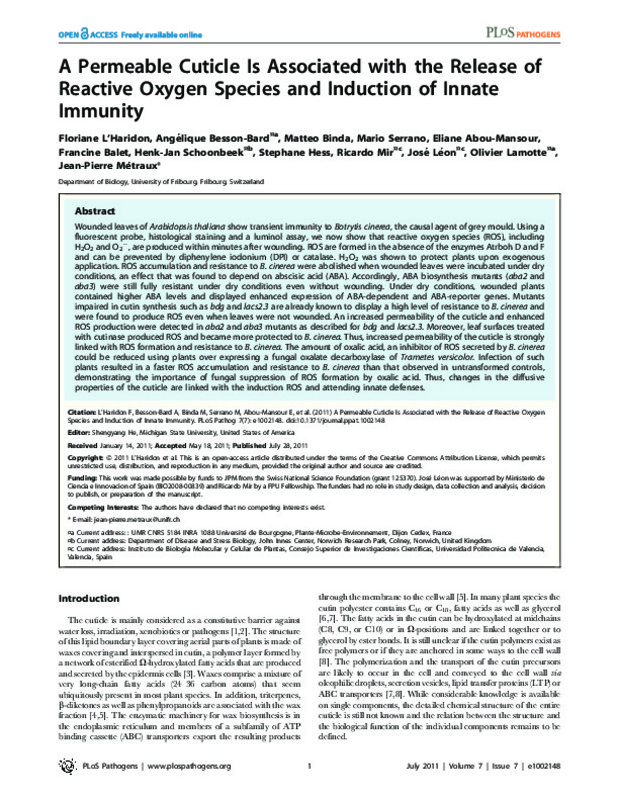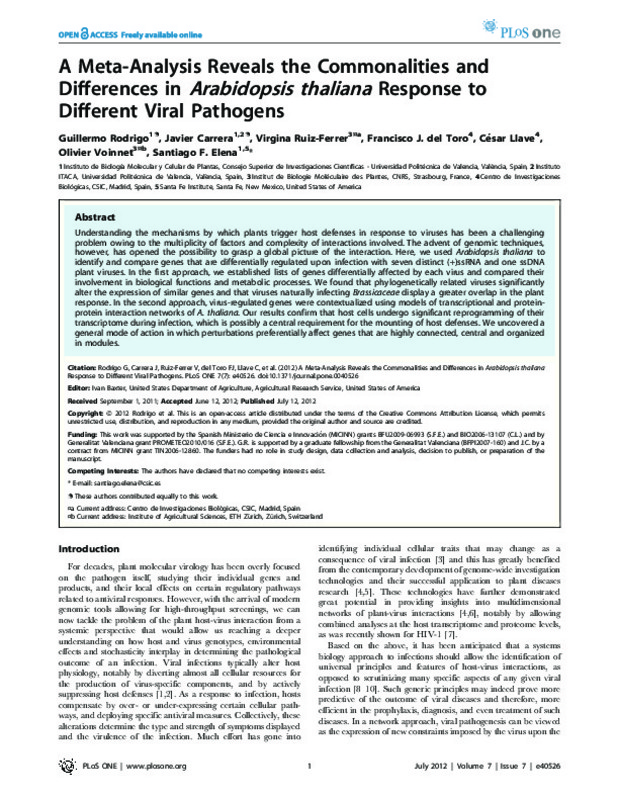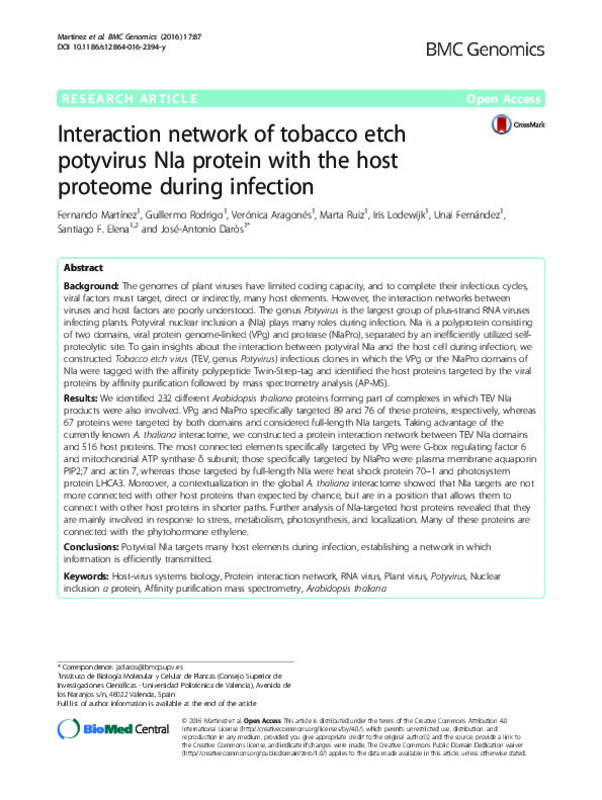Riederer, M., & Schreiber, L. (2001). Protecting against water loss: analysis of the barrier properties of plant cuticles. Journal of Experimental Botany, 52(363), 2023-2032. doi:10.1093/jexbot/52.363.2023
Nawrath, C. (2006). Unraveling the complex network of cuticular structure and function. Current Opinion in Plant Biology, 9(3), 281-287. doi:10.1016/j.pbi.2006.03.001
Kunst, L., & Samuels, L. (2009). Plant cuticles shine: advances in wax biosynthesis and export. Current Opinion in Plant Biology, 12(6), 721-727. doi:10.1016/j.pbi.2009.09.009
[+]
Riederer, M., & Schreiber, L. (2001). Protecting against water loss: analysis of the barrier properties of plant cuticles. Journal of Experimental Botany, 52(363), 2023-2032. doi:10.1093/jexbot/52.363.2023
Nawrath, C. (2006). Unraveling the complex network of cuticular structure and function. Current Opinion in Plant Biology, 9(3), 281-287. doi:10.1016/j.pbi.2006.03.001
Kunst, L., & Samuels, L. (2009). Plant cuticles shine: advances in wax biosynthesis and export. Current Opinion in Plant Biology, 12(6), 721-727. doi:10.1016/j.pbi.2009.09.009
Samuels, L., Kunst, L., & Jetter, R. (2008). Sealing Plant Surfaces: Cuticular Wax Formation by Epidermal Cells. Annual Review of Plant Biology, 59(1), 683-707. doi:10.1146/annurev.arplant.59.103006.093219
Kolattukudy, P. E., Rogers, L. M., Li, D., Hwang, C. S., & Flaishman, M. A. (1995). Surface signaling in pathogenesis. Proceedings of the National Academy of Sciences, 92(10), 4080-4087. doi:10.1073/pnas.92.10.4080
Heredia, A. (2003). Biophysical and biochemical characteristics of cutin, a plant barrier biopolymer. Biochimica et Biophysica Acta (BBA) - General Subjects, 1620(1-3), 1-7. doi:10.1016/s0304-4165(02)00510-x
Pollard, M., Beisson, F., Li, Y., & Ohlrogge, J. B. (2008). Building lipid barriers: biosynthesis of cutin and suberin. Trends in Plant Science, 13(5), 236-246. doi:10.1016/j.tplants.2008.03.003
Comménil, P., Belingheri, L., & Dehorter, B. (1998). Antilipase antibodies prevent infection of tomato leaves byBotrytis cinerea. Physiological and Molecular Plant Pathology, 52(1), 1-14. doi:10.1006/pmpp.1997.0130
MAITI, I. B., & KOLATTUKUDY, P. E. (1979). Prevention of Fungal Infection of Plants by Specific Inhibition of Cutinase. Science, 205(4405), 507-508. doi:10.1126/science.205.4405.507
Li, D., Ashby, A. M., & Johnstone, K. (2003). Molecular Evidence that the Extracellular Cutinase Pbc1 Is Required for Pathogenicity ofPyrenopeziza brassicaeon Oilseed Rape. Molecular Plant-Microbe Interactions, 16(6), 545-552. doi:10.1094/mpmi.2003.16.6.545
Rogers, L. M., Flaishman, M. A., & Kolattukudy, P. E. (1994). Cutinase gene disruption in Fusarium solani f sp pisi decreases its virulence on pea. The Plant Cell, 6(7), 935-945. doi:10.1105/tpc.6.7.935
REIS, H., PFIFFI, S., & HAHN, M. (2005). Molecular and functional characterization of a secreted lipase fromBotrytis cinerea. Molecular Plant Pathology, 6(3), 257-267. doi:10.1111/j.1364-3703.2005.00280.x
Stahl, D. J. (1994). Cutinase ofNectria haematococca(Fusarium solanif.sp.pisi)Is Not Requiredfor Fungal Virulence or Organ Specificity on Pea. Molecular Plant-Microbe Interactions, 7(6), 713. doi:10.1094/mpmi-7-0713
Van Kan, J. A. L., van ’t Klooster, J. W., Wagemakers, C. A. M., Dees, D. C. T., & van der Vlugt-Bergmans, C. J. B. (1997). Cutinase A ofBotrytis cinereais Expressed, but not Essential, During Penetration of Gerbera and Tomato. Molecular Plant-Microbe Interactions, 10(1), 30-38. doi:10.1094/mpmi.1997.10.1.30
Woloshuk, C. P., & Kolattukudy, P. E. (1986). Mechanism by which contact with plant cuticle triggers cutinase gene expression in the spores of Fusarium solani f. sp. pisi. Proceedings of the National Academy of Sciences, 83(6), 1704-1708. doi:10.1073/pnas.83.6.1704
Francis, S. A., Dewey, F. M., & Gurr, S. J. (1996). The role of cutinase in germling development and infection byErysiphe graminisf.sp.hordei. Physiological and Molecular Plant Pathology, 49(3), 201-211. doi:10.1006/pmpp.1996.0049
Gilbert, R. D., Johnson, A. M., & Dean, R. A. (1996). Chemical signals responsible for appressorium formation in the rice blast fungusMagnaporthe grisea. Physiological and Molecular Plant Pathology, 48(5), 335-346. doi:10.1006/pmpp.1996.0027
Podila, G. K., Rogers, L. M., & Kolattukudy, P. E. (1993). Chemical Signals from Avocado Surface Wax Trigger Germination and Appressorium Formation in Colletotrichum gloeosporioides. Plant Physiology, 103(1), 267-272. doi:10.1104/pp.103.1.267
Schweizer, P., Felix, G., Buchala, A., Muller, C., & Metraux, J.-P. (1996). Perception of free cutin monomers by plant cells. The Plant Journal, 10(2), 331-341. doi:10.1046/j.1365-313x.1996.10020331.x
Fauth, M., Schweizer, P., Buchala, A., Markstädter, C., Riederer, M., Kato, T., & Kauss, H. (1998). Cutin Monomers and Surface Wax Constituents Elicit H2O2 in Conditioned Cucumber Hypocotyl Segments and Enhance the Activity of Other H2O2Elicitors. Plant Physiology, 117(4), 1373-1380. doi:10.1104/pp.117.4.1373
Apel, K., & Hirt, H. (2004). REACTIVE OXYGEN SPECIES: Metabolism, Oxidative Stress, and Signal Transduction. Annual Review of Plant Biology, 55(1), 373-399. doi:10.1146/annurev.arplant.55.031903.141701
Torres, M. A., Jones, J. D. G., & Dangl, J. L. (2006). Reactive Oxygen Species Signaling in Response to Pathogens: Figure 1. Plant Physiology, 141(2), 373-378. doi:10.1104/pp.106.079467
Torres, M. A. (2010). ROS in biotic interactions. Physiologia Plantarum, 138(4), 414-429. doi:10.1111/j.1399-3054.2009.01326.x
Parker, D. M., & Köller, W. (1998). Cutinase and Other Lipolytic Esterases Protect Bean Leaves from Infection byRhizoctonia solani. Molecular Plant-Microbe Interactions, 11(6), 514-522. doi:10.1094/mpmi.1998.11.6.514
Sieber, P., Schorderet, M., Ryser, U., Buchala, A., Kolattukudy, P., Métraux, J.-P., & Nawrath, C. (2000). Transgenic Arabidopsis Plants Expressing a Fungal Cutinase Show Alterations in the Structure and Properties of the Cuticle and Postgenital Organ Fusions. The Plant Cell, 12(5), 721-737. doi:10.1105/tpc.12.5.721
Wellesen, K., Durst, F., Pinot, F., Benveniste, I., Nettesheim, K., Wisman, E., … Yephremov, A. (2001). Functional analysis of the LACERATA gene of Arabidopsis provides evidence for different roles of fatty acid -hydroxylation in development. Proceedings of the National Academy of Sciences, 98(17), 9694-9699. doi:10.1073/pnas.171285998
Kurdyukov, S., Faust, A., Nawrath, C., Bär, S., Voisin, D., Efremova, N., … Yephremov, A. (2006). The Epidermis-Specific Extracellular BODYGUARD Controls Cuticle Development and Morphogenesis in Arabidopsis. The Plant Cell, 18(2), 321-339. doi:10.1105/tpc.105.036079
Bessire, M., Chassot, C., Jacquat, A.-C., Humphry, M., Borel, S., Petétot, J. M.-C., … Nawrath, C. (2007). A permeable cuticle in Arabidopsis leads to a strong resistance to Botrytis cinerea. The EMBO Journal, 26(8), 2158-2168. doi:10.1038/sj.emboj.7601658
Boller, T., & Felix, G. (2009). A Renaissance of Elicitors: Perception of Microbe-Associated Molecular Patterns and Danger Signals by Pattern-Recognition Receptors. Annual Review of Plant Biology, 60(1), 379-406. doi:10.1146/annurev.arplant.57.032905.105346
Chassot, Cã©., Buchala, A., Schoonbeek, H., Métraux, J.-P., & Lamotte, O. (2008). Wounding of Arabidopsis leaves causes a powerful but transient protection againstBotrytisinfection. The Plant Journal, 55(4), 555-567. doi:10.1111/j.1365-313x.2008.03540.x
León, J., Rojo, E., & Sánchez‐Serrano, J. J. (2001). Wound signalling in plants. Journal of Experimental Botany, 52(354), 1-9. doi:10.1093/jexbot/52.354.1
Orozco-Cárdenas, M. L., Narváez-Vásquez, J., & Ryan, C. A. (2001). Hydrogen Peroxide Acts as a Second Messenger for the Induction of Defense Genes in Tomato Plants in Response to Wounding, Systemin, and Methyl Jasmonate. The Plant Cell, 13(1), 179-191. doi:10.1105/tpc.13.1.179
Hempel, S. L., Buettner, G. R., O’Malley, Y. Q., Wessels, D. A., & Flaherty, D. M. (1999). Dihydrofluorescein diacetate is superior for detecting intracellular oxidants: comparison with 2′,7′-dichlorodihydrofluorescein diacetate, 5(and 6)-carboxy-2′,7′-dichlorodihydrofluorescein diacetate, and dihydrorhodamine 123. Free Radical Biology and Medicine, 27(1-2), 146-159. doi:10.1016/s0891-5849(99)00061-1
Warm, E., & Laties, G. G. (1982). Quantification of hydrogen peroxide in plant extracts by the chemiluminescence reaction with luminol. Phytochemistry, 21(4), 827-831. doi:10.1016/0031-9422(82)80073-3
Lozano-Juste, J., & León, J. (2009). Enhanced Abscisic Acid-Mediated Responses in nia1nia2noa1-2 Triple Mutant Impaired in NIA/NR- and AtNOA1-Dependent Nitric Oxide Biosynthesis in Arabidopsis. Plant Physiology, 152(2), 891-903. doi:10.1104/pp.109.148023
Voisin, D., Nawrath, C., Kurdyukov, S., Franke, R. B., Reina-Pinto, J. J., Efremova, N., … Yephremov, A. (2009). Dissection of the Complex Phenotype in Cuticular Mutants of Arabidopsis Reveals a Role of SERRATE as a Mediator. PLoS Genetics, 5(10), e1000703. doi:10.1371/journal.pgen.1000703
Prins, T. W., Tudzynski, P., von Tiedemann, A., Tudzynski, B., Ten Have, A., Hansen, M. E., … van Kan, J. A. L. (2000). Infection Strategies of Botrytis cinerea and Related Necrotrophic Pathogens. Fungal Pathology, 33-64. doi:10.1007/978-94-015-9546-9_2
Cessna, S. G., Sears, V. E., Dickman, M. B., & Low, P. S. (2000). Oxalic Acid, a Pathogenicity Factor for Sclerotinia sclerotiorum, Suppresses the Oxidative Burst of the Host Plant. The Plant Cell, 12(11), 2191-2199. doi:10.1105/tpc.12.11.2191
Walz, A., Zingen-Sell, I., Theisen, S., & Kortekamp, A. (2007). Reactive oxygen intermediates and oxalic acid in the pathogenesis of the necrotrophic fungus Sclerotinia sclerotiorum. European Journal of Plant Pathology, 120(4), 317-330. doi:10.1007/s10658-007-9218-5
Hoffmann, A., Hammes, E., Plieth, C., Desel, C., Sattelmacher, B., & Hansen, U.-P. (2005). Effect of CO2 supply on formation of reactive oxygen species in Arabidopsis thaliana. Protoplasma, 227(1), 3-9. doi:10.1007/s00709-005-0133-3
Kessler, A., & Baldwin, I. T. (2002). PLANTRESPONSES TOINSECTHERBIVORY: The Emerging Molecular Analysis. Annual Review of Plant Biology, 53(1), 299-328. doi:10.1146/annurev.arplant.53.100301.135207
VAN BAARLEN, P., WOLTERING, E. J., STAATS, M., & VAN KAN, J. A. L. (2007). Histochemical and genetic analysis of host and non-host interactions of Arabidopsis with three Botrytis species: an important role for cell death control. Molecular Plant Pathology, 8(1), 41-54. doi:10.1111/j.1364-3703.2006.00367.x
Chassot, C., Nawrath, C., & Métraux, J.-P. (2007). Cuticular defects lead to full immunity to a major plant pathogen. The Plant Journal, 49(6), 972-980. doi:10.1111/j.1365-313x.2006.03017.x
Wu, Y., Sanchez, J. P., Lopez-Molina, L., Himmelbach, A., Grill, E., & Chua, N.-H. (2003). The abi1-1 mutation blocks ABA signaling downstream of cADPR action. The Plant Journal, 34(3), 307-315. doi:10.1046/j.1365-313x.2003.01721.x
Himmelbach, A. (2002). Homeodomain protein ATHB6 is a target of the protein phosphatase ABI1 and regulates hormone responses in Arabidopsis. The EMBO Journal, 21(12), 3029-3038. doi:10.1093/emboj/cdf316
Asselbergh, B., Curvers, K., França, S. C., Audenaert, K., Vuylsteke, M., Van Breusegem, F., & Höfte, M. (2007). Resistance to Botrytis cinerea in sitiens, an Abscisic Acid-Deficient Tomato Mutant, Involves Timely Production of Hydrogen Peroxide and Cell Wall Modifications in the Epidermis. Plant Physiology, 144(4), 1863-1877. doi:10.1104/pp.107.099226
Mauch-Mani, B., & Mauch, F. (2005). The role of abscisic acid in plant–pathogen interactions. Current Opinion in Plant Biology, 8(4), 409-414. doi:10.1016/j.pbi.2005.05.015
Raghavendra, A. S., Gonugunta, V. K., Christmann, A., & Grill, E. (2010). ABA perception and signalling. Trends in Plant Science, 15(7), 395-401. doi:10.1016/j.tplants.2010.04.006
Curvers, K., Seifi, H., Mouille, G., de Rycke, R., Asselbergh, B., Van Hecke, A., … Höfte, M. (2010). Abscisic Acid Deficiency Causes Changes in Cuticle Permeability and Pectin Composition That Influence Tomato Resistance to Botrytiscinerea. Plant Physiology, 154(2), 847-860. doi:10.1104/pp.110.158972
Schoonbeek, H., Jacquat-Bovet, A.-C., Mascher, F., & Métraux, J.-P. (2007). Oxalate-Degrading Bacteria Can ProtectArabidopsis thalianaand Crop Plants AgainstBotrytis cinerea. Molecular Plant-Microbe Interactions, 20(12), 1535-1544. doi:10.1094/mpmi-20-12-1535
Walz, A., Zingen-Sell, I., Loeffler, M., & Sauer, M. (2008). Expression of an oxalate oxidase gene in tomato and severity of disease caused by Botrytis cinerea and Sclerotinia sclerotiorum. Plant Pathology, 57(3), 453-458. doi:10.1111/j.1365-3059.2007.01815.x
Siewers, V., Kokkelink, L., Smedsgaard, J., & Tudzynski, P. (2006). Identification of an Abscisic Acid Gene Cluster in the Grey Mold Botrytis cinerea. Applied and Environmental Microbiology, 72(7), 4619-4626. doi:10.1128/aem.02919-05
Siewers, V., Smedsgaard, J., & Tudzynski, P. (2004). The P450 Monooxygenase BcABA1 Is Essential for Abscisic Acid Biosynthesis in Botrytis cinerea. Applied and Environmental Microbiology, 70(7), 3868-3876. doi:10.1128/aem.70.7.3868-3876.2004
Kettner, J., & D�rffling, K. (1995). Biosynthesis and metabolism of abscisic acid in tomato leaves infected withBotrytis cinerea. Planta, 196(4), 627-634. doi:10.1007/bf01106753
Temme, N., & Tudzynski, P. (2009). DoesBotrytis cinereaIgnore H2O2-Induced Oxidative Stress During Infection? Characterization ofBotrytisActivator Protein 1. Molecular Plant-Microbe Interactions, 22(8), 987-998. doi:10.1094/mpmi-22-8-0987
Leon-Kloosterziel, K. M., Gil, M. A., Ruijs, G. J., Jacobsen, S. E., Olszewski, N. E., Schwartz, S. H., … Koornneef, M. (1996). Isolation and characterization of abscisic acid-deficient Arabidopsis mutants at two new loci. The Plant Journal, 10(4), 655-661. doi:10.1046/j.1365-313x.1996.10040655.x
Mengiste, T., Chen, X., Salmeron, J., & Dietrich, R. (2003). The BOTRYTIS SUSCEPTIBLE1 Gene Encodes an R2R3MYB Transcription Factor Protein That Is Required for Biotic and Abiotic Stress Responses in Arabidopsis. The Plant Cell, 15(11), 2551-2565. doi:10.1105/tpc.014167
Thordal-Christensen, H., Zhang, Z., Wei, Y., & Collinge, D. B. (1997). Subcellular localization of H2O2 in plants. H2O2 accumulation in papillae and hypersensitive response during the barley-powdery mildew interaction. The Plant Journal, 11(6), 1187-1194. doi:10.1046/j.1365-313x.1997.11061187.x
Chen, Z., Silva, H., & Klessig, D. (1993). Active oxygen species in the induction of plant systemic acquired resistance by salicylic acid. Science, 262(5141), 1883-1886. doi:10.1126/science.8266079
Christmann, A., Hoffmann, T., Teplova, I., Grill, E., & Müller, A. (2004). Generation of Active Pools of Abscisic Acid Revealed by In Vivo Imaging of Water-Stressed Arabidopsis. Plant Physiology, 137(1), 209-219. doi:10.1104/pp.104.053082
Czechowski, T., Stitt, M., Altmann, T., Udvardi, M. K., & Scheible, W.-R. (2005). Genome-Wide Identification and Testing of Superior Reference Genes for Transcript Normalization in Arabidopsis. Plant Physiology, 139(1), 5-17. doi:10.1104/pp.105.063743
Van Gemeren, I. A., Musters, W., van den Hondel, C. A. M. J. J., & Verrips, C. T. (1995). Construction and heterologous expression of a synthetic copy of the cutinase cDNA from Fusarium solani pisi. Journal of Biotechnology, 40(3), 155-162. doi:10.1016/0168-1656(95)00041-n
Franke, R., Briesen, I., Wojciechowski, T., Faust, A., Yephremov, A., Nawrath, C., & Schreiber, L. (2005). Apoplastic polyesters in Arabidopsis surface tissues – A typical suberin and a particular cutin. Phytochemistry, 66(22), 2643-2658. doi:10.1016/j.phytochem.2005.09.027
Clough, S. J., & Bent, A. F. (1998). Floral dip: a simplified method forAgrobacterium-mediated transformation ofArabidopsis thaliana. The Plant Journal, 16(6), 735-743. doi:10.1046/j.1365-313x.1998.00343.x
[-]












